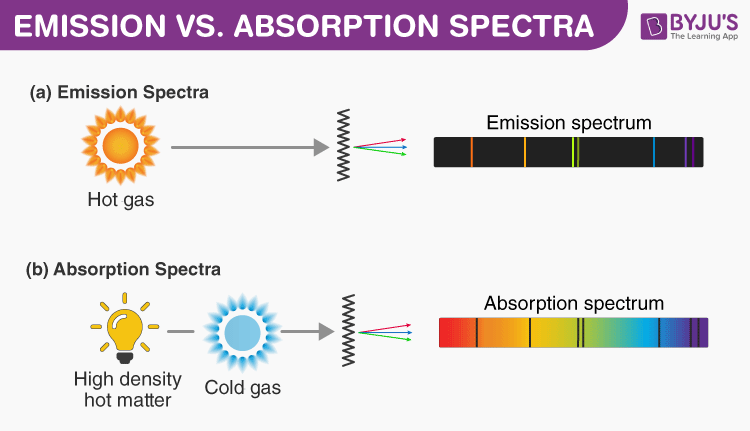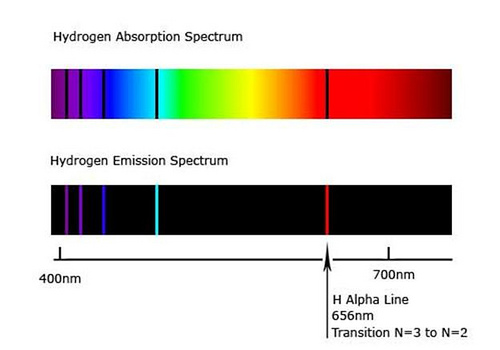This is why hydrogens emission spectrum is the inverse of its absorption spectrum with emission lines at 410 nm violet 434 nm blue 486 nm blue. The same concepts used to describe the emission and absorption of virtual photons in electromagnetic interactions can be used to describe nuclear interactions.
Emission Absorption Spectrum Emission Absorption Spectroscopy Line Spectrum
Emission and Absorption Spectra.

. The absorption spectrum is the opposite of the emission spectrum. When an electron drops down between levels it emits photons with the same amount of energythe same wavelengththat it would need to absorb in order to move up between those same levels. Normally it is used to see whether there are certain metals in a chemical compound.
408 explain how emission and absorption of radiation are related to surface and temperature. According to this theory when two protons of a nucleus interact with each other a virtual particle is created. Emission and Absorption Spectra.
The spectrum thus obtained is known as the absorption spectrum. The same concepts used to describe the emission and absorption of virtual photons in electromagnetic interaction can be used to describe nucleus interactions. 371 we includeinaccurate measurements of.
Here is a great YouTube video explaining and showing the excitement of electrons emission and. Absorption is when electrons gain energy and jump to higher energy levels. As we have noted in the section on the Bohr atom isolated atoms can absorb and emit packets of electromagnetic radiation having discrete energies dictated by.
Thesamewavelengthrange3200to3600Ainvacuumasincaesium 360 Bureau oj StandardsJournal of Research Vol8 vaporIn paperNo. Dark matt surfaces are poor reflectors and good at absorbing IR. Absorption and emission of light reveals details about the atomic structure of an atom by telling us the amount of energy levels and the space between the energy levels.
According to this theory when two protons of a nucleus interact with each other a virtual particle is created. The structure of an atom includes a central core called a nucleus and a cloud of electrons around the nucleus. Towards Quantum Mechanical Model of Atom.
The emission spectrum is quite different from the absorption spectrum. Absorption of radiation or light. Stimulated emission occurs when a photon with energy equal to the energy gap of the levels interacts with the electron.
Main Difference Absorption vs Emission Spectra. The process of absorbing energy from photons is called absorption of radiation. Atomic emission is the energy released from an excited atom as it goes back down to its ground state emitting discrete wavelengths.
Conservation of energy determines the energy of the photon and thus the frequency of the emitted or absorbed light. Atoms molecules and ions that have absorbed radiation are called excited. During absorption an electron takes energy from an incoming photon and the internal energy of the electron increases.
The dark line pattern is seen exactly in the same place where coloured lines are seen in the emission spectrum. According to the modern atomic theory these electrons are positioned in specific energy levels called shells or orbitals where their energies are quantized. A flame test is a test for chemicals.
Absorption of radiation or light. An atom can absorb or emit one photon when an electron makes a transition from one stationary state or energy level to another. Atomic Absorption and Emission Spectra.
The emission spectrum is the spectrum of radiation emitted by a substance that has absorbed energy. Absorption spectra are measured by varying the wavelength of the incident light using a monochromator and recording the intensity. The chemical compound is heated in a flame and a colored flame is made.
The gaps in the spectrum of the Sun get developed and help in informing the formation of the sun. In 1955 Alan Walsh from Australia applied the principle and instrumentation of atomic absorption spectroscopy for the. This means that placed next to a heat source a dark object would heat up faster than a light one.
The electrons that are very close to the nucleus have lowest energy level. Emission spectra can emit all the colours in an electromagnetic spectrum while the absorption spectrum can have a few colours missing due to the redirection of absorbed photons. Light shiny surfaces are good reflectors of IR and so are poor at absorbing it.
In developing an absorption spectrum the light needs to shine through a gas but in creating and emission spectrum a gas needs to be heated up. The same concepts used to describe the emission and absorption of virtual photons in electromagnetic interactions can be used to describe nuclear interactions. It was first observed by Fraunhofer while studying dark lines in the solar spectrum.
Atomic absorption spectroscopy AAS and atomic emission spectroscopy AES principle is based upon the absorption and emission of light by atoms in the gaseous state. Atomic absorption is when an atom absorbs light to go from a ground state to an excited state. The difference between absorption and emission spectra are that absorption lines are where light has been absorbed by the atom thus you see a dip in the spectrum whereas emission spectra have spikes in the spectra due to atoms releasing photons at those wavelengths.
The colored flame can be turned into its spectrum to. It is well known that there are different energy levels in an atom. During spontaneous emission the internal energy of an electron decreases and a photon is emitted.
Absorption spectra also known as UV-Vis spectra absorbance spectra and electronic spectra show the change in absorbance of a sample as a function of the wavelength of incident light Figure 1 and are measured using a spectrophotometer. According to this theory when two protons of a nucleus interact with each other a virtual particle is created.

Spectroscopy Why Absorption Spectum Is Not Identical To Emission Spectrum Physics Stack Exchange

Difference Between Emission And Absorption Spectra Comparison Chart

Absorption Spectrum Emission Spectrum Lines Article Khan Academy
0 Comments